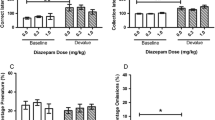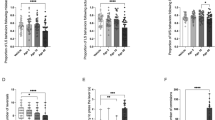Summary
Studies of the behavioural effects of benzodiazepines have focused in particular on situations with negative secondary stimuli, i.e., stimuli signalling negative primary events such as punishment or non-reward. The general result is that benzodiazepines attenuate behavioural reactions to this type of stimuli. The aim of the present study was to investigate if there are any differences between positive and negative secondary stimuli in this respect. Rats were treated with diazepam in a modified Skinner box with two levers. One of the levers always gave a small reward. A lamp being ON or OFF was used as a secondary stimulus indicating if the other lever would give a large or no reward. Pretreatment with diazepam (1.0 mg/kg) did not act differently on the response to the positive or negative secondary stimulus. The main effect was a general attenuation of optimal responding with a concomitant decrease in water intake. An alternative hypothesis stating that benzodiazepines alter the reactivity to secondary stimuli more in general is supported.
Similar content being viewed by others
References
Dantzer R (1977) Behavioral effects of benzodiazepines: a review. Biobehavioural Review 1: 71–86
Gray JA (1978) The neuropsychology of anxiety: a synopsis of the 1977 Myers lecture. Br Psychol Soc 31: 33–35
Gray JA (1981) Anxiety as a paradigm case of emotion. Br Med Bull 37: 193–197
Gray JA (1982) Precise of the neuropsychology of anxiety: an enquiry into the functions of the septo-hippocampal system. Behav Brain Sci 5: 469–534
Haefely WE (1978) Behavioural and neuropharmacological aspects of drugs used in anxiety and related states. In: Lipton MA, DiMascio A, Killam KF (eds) Psychopharmacology: a generation in progress. Raven Press, New York, pp 1359–1374
Hasegawa Y, Ibuka N, Iwahara S (1973) Effects of chlordiazepoxide upon successive red-green discrimination responses in Japanese monkeys,Macaca fuscata. Psychopharmacologia 30: 89–94
Hodges H, Green S (1987) Are the effects of benzodiazepines on discrimination and punishment dissociable? Physiol Behav 41: 247–264
Ljungberg T (1987) Blockade by neuroleptics of water intake and operant responding for water in the rat: anhedonia, motor deficit or both? Pharmacol Biochem Behav 27: 341–350
Ljungberg T, Enquist M (1986) Decision making by rats in an unpredictable laboratory environment: final decision rules. Anim Behav 34: 1120–1128
Ljungberg T, Lidfors L, Enquist M, Ungerstedt U (1987) Impairment of decision making in rats by diazepam: implications for the “anti-conflict” effects of benzo-diazepines. Psychopharmacology 92: 416–423
Nicholson AN, Wright CM (1974) Inhibitory and disinhibitory effects of nitrazepam, diazepam and flurazepam hydrochloride on delayed matching behaviour in monkeys (Macaca mulatta). Neuropharmacology 13: 919–926
Nicholson AN, Wright CM (1980) Comparative studies with thieno- and benzodiazepines: spatial delayed alternation behaviour in the monkey (Macaca mulatta). Neuropharmacology 19: 491–495
Sahgal A, Iversen SD (1978) The effects of chlordiazepoxide on a delayed pair comparison task in pigeons. Psychopharmacology 59: 57–64
Sepinwall J, Cook L (1978) Behavioral pharmacology of antianxiety drugs. In: Iversen SD, Snyder SD (eds) Handbook of psychopharmacology. Plenum Press, New York (Plenum Press, vol 13, pp 345–393)
Siegel S (1956) Nonparametric statistics for the behavioral sciences. McGraw-Hill Kogakusha, Tokyo
Thiebot MH, Soubrie P (1983) Behavioral pharmacology of the benzodiazepines. In: Costa EM (ed) The benzodiazepines. Raven Press, New York, pp 67–92
Author information
Authors and Affiliations
Rights and permissions
About this article
Cite this article
Enquist, M., Forkman, B. & Ljungberg, T. Is the behavioural effect of diazepam in rats unique to negative secondary stimuli?. J. Neural Transmission 81, 147–152 (1990). https://doi.org/10.1007/BF01245834
Received:
Accepted:
Issue Date:
DOI: https://doi.org/10.1007/BF01245834




